22 Reasons Why Your SaaS Is Losing a Ton of Money (And How to Fix That)
Inspired by the growing popularity of SaaS (Software as a Service) companies, we’ve decided to take a closer look at buzz around this type of solutions (which comes pretty handy given that the biggest & most awaited SaaS event of the year, SaaStr Annual begins today). For the purpose of this analysis, we’ve examined mentions from the last 8 months which we gathered with Brand24 social listening tool.
The following analysis is focused on problems faced by users of various SaaS companies, as well as key communication channels they choose to voice their opinions. It also offers advice on improving your SaaS business, lists industry influencers and most prominent SaaS-related subjects. This material has been published to help businesses improve their product and present industry insights valuable for those willing to launchtheir first SaaS.
Where does the discussion take place?
When it comes to discussion on SaaS-related subjects, Twitter is by far the most active of all social networks. In the last 8 months, there’s been over 700,000 mentions on “SaaS” across Twitter, which accounts for 80% of all mentions collected in the course of this analysis. Our tool returned 37,000 and 20,000 mentions for Facebook and Google+ respectively. However, mentions could also be found outside social media channels – in the analyzed time period, blogs generated over 19,000 submissions, and news sites produced over 23,000 mentions.
Universal problems faced by SaaS users
SaaS users reported a number of problems, including pricing, bad customer service and payment difficulties, to name but a few. Given that these issues have a direct influence on customer acquisition and customer retention, it is worth examining them in detail.
1. Steep price tag
Subscription-based access to a service lies at the essence of the SaaS business model. Payment may be made every month, or for a longer period of time (e.g. annually). Some companies decide to opt for buying the software outright, which they think in the long run is cheaper than subscription-based cloud solutions.
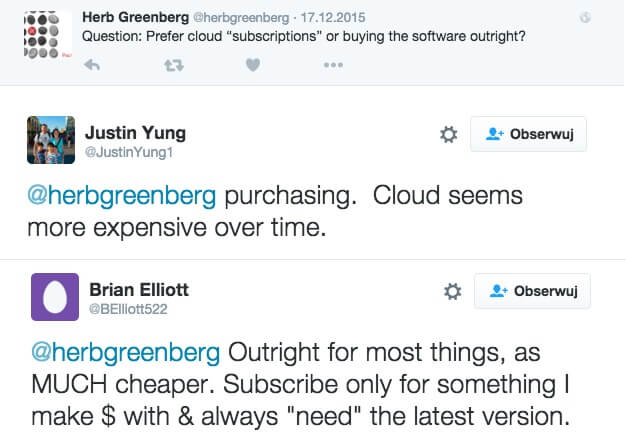
2. Insufficient pricing information
Pricing issues don’t end with steep price tags – some businesses fail to provide sufficient pricing information on their websites. Customers wish to know the exact price before they start a free trial or are approached by a sales representative. For many people, not being able to check a price of a given tool means it’s probably too expensive for them.

Some users also get frustrated with having to fill out forms to get a price estimate.

3. No access to data in the case of delayed payments
Monthly charge model can be problematic to some users. They know they can lose access to their account and potentially lose some key business data should they fail to make a payment on time. This can serve as a serious barrier to new users.
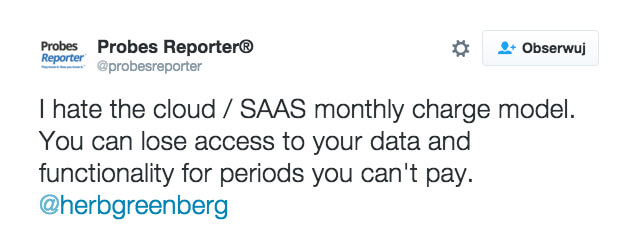
4. Limited payment options
Limited payment options are the subject of numerous customer complaints. Make sure you give users plenty of payment options. Here’s a really cool example: last January, BillingServ announced they accept Paycoin, Bitcoin, and Dogecoin payments.
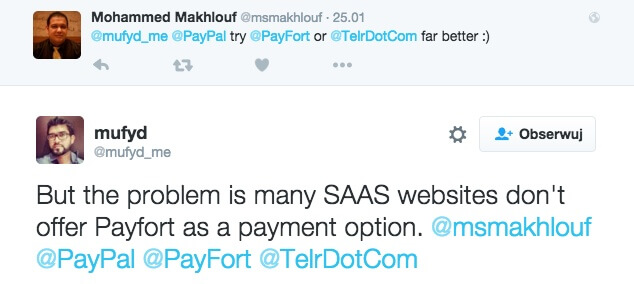
5. Frustrating onboarding experience
While some of your new users expect you to walk them through your tool step by step, others prefer to be left alone so they can explore it by themselves. Finding balance between user preferences can prove extremely tough – you should always focus on making things easy and intuitive for new users to prevent them from getting discouraged from what you have to offer. Analyze how many steps it takes to set up a new account, how you collect data, or how you reach out to provide additional information. Think about how these activities affect UX.


6. Delays in data transfer
All SaaS user data is stored on external servers, which may have serious implications for some users. Many companies operating globally have customers from all over the world, which may result in delays to customers most distant from the location of the servers.

7. Too many notifications
Practically all SaaS solutions send emails with advice on how to use the tool to maximize its potential, as well as provide additional information related to the subject. It is pretty clear that people find this annoying – make sure your emails are not intrusive (i.e. not too frequent).


8. Trust issues
Trust is essential for this type of businesses – not only do customers trust you with their money, they also trust you with sensitive data relevant to their business. When a given SaaS company goes out of business, its customers are affected enormously, especially if they paid for their access in advance (e.g. paid an annual fee). Let’s be realistic: a lot of SaaS companies fail, which makes it difficult for new companies to instill trust and build rapport .

9. Trouble downloading invoices
Most SaaS businesses address their solutions at the B2B sector, so you’d think downloading invoices would feel like a breeze. Making this process difficult (or not offering downloadable invoices at all) is considered a grave error by some SaaS users.

[mid_banner]
10. Asking for credit card details for a free trial
Asking users for their credit card details in the free trial registration form is a serious barrier to entry. A lot of people would like to give your tool a try, but they feel like asking for this type of information at such an early stage is unnecessary.
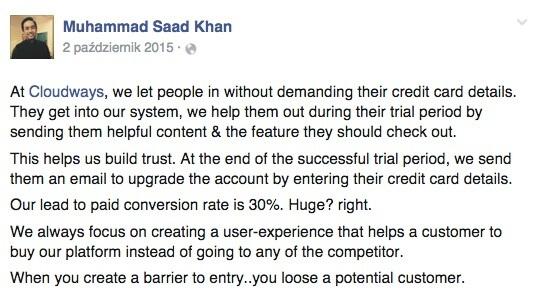
11. One API key
SaaS solutions providing only one API key make it difficult for users to integrate across tools to increase efficiency. One API key means users have to choose between services which are equally important to their business.

12. Complicated cancellation process
It is believed that some SaaS businesses make cancelling purposely hard – it comes as no wonder users are getting frustrated and complain about such practices.
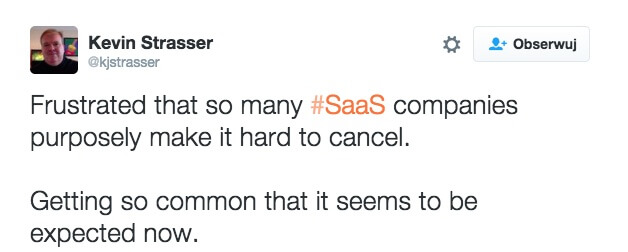
13. No explanation of tool purpose
In many cases, your site is often the first place for users to learn about your SaaS tool. Businesses try and squeeze as much information as possible on their precious website space, but they often forget to provide a clear description of what their tool actually does.
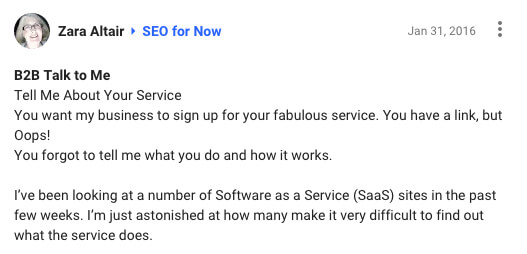
14. Not using Intercom
In the SaaS sector, Intercom is constantly gaining momentum because it’s so versatile – it can generate sales and be used for by helpdesk staff, among other things. Some users feel that SaaS tools that don’t come with Intercom are not worth the hassle. According to Intercom’s analysis, both the design and usability of the tool are appreciated by majority of their users. For that reason, Intercom can serve as a role model for many SaaS businesses.

15. Inability to reject new terms
Users find fault with SaaS products which don’t allow them to reject or negotiate new terms imposed upon them while actively using the tool.
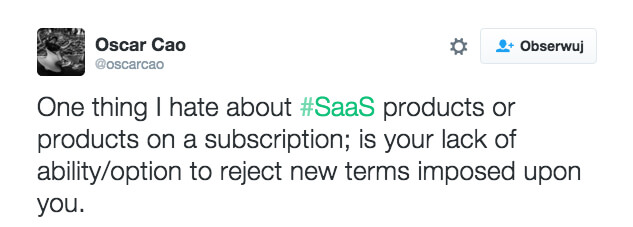
16. Bad customer service
CAC (Customer Acquisition Cost) is typically even a few times higher than CRC (Customer Retention Cost), but nothing is costing you more customers than bad customer service.
Taking too long to answer a question, or not answering at all are only a couple of ways you can decrease customer satisfaction. Ignoring complaints can put your company on fast track to social media crisis, so make sure you answer in a polite, timely and informative manner.


Problems faced by specific companies
17. ADOBE: No way to change payment method
An unsatisfied Adobe user voiced her concerns on Twitter upon learning that she had to cancel her subscription to change her payment method (i.e. switch from PayPal to credit card). Your aim should be to make things as easy as possible for your customers to increase their satisfaction.

18. Mint: No way to add multiple users to one billing account
Mint customers reported it was impossible to add a multiple users to one billing account, which is something you’d expect from a budget & personal finances app. A lot of users get Mint to plan & control their family budgets, so it’s only logical that they would like to share their account with their spouses, relatives, or housemates – some of them said they would even be happy to pay extra to be able to do so.

19. HubSpot: UX issues
Sidekick is a service which allows you to track & schedule your emails. According to one of Twitter users, its Business plan comes with an apparently overcomplicated purchasing process.

20. HubSpot: Annoying Marketing Automation
One of Twitter users got an automated email asking for permission to close his file, followed by an almost identical email of this kind two days after he got the first message. This serves as a great example of how annoying Marketing Automation can be for its recipients (hence the “Hubspot Sales Zombies” part).
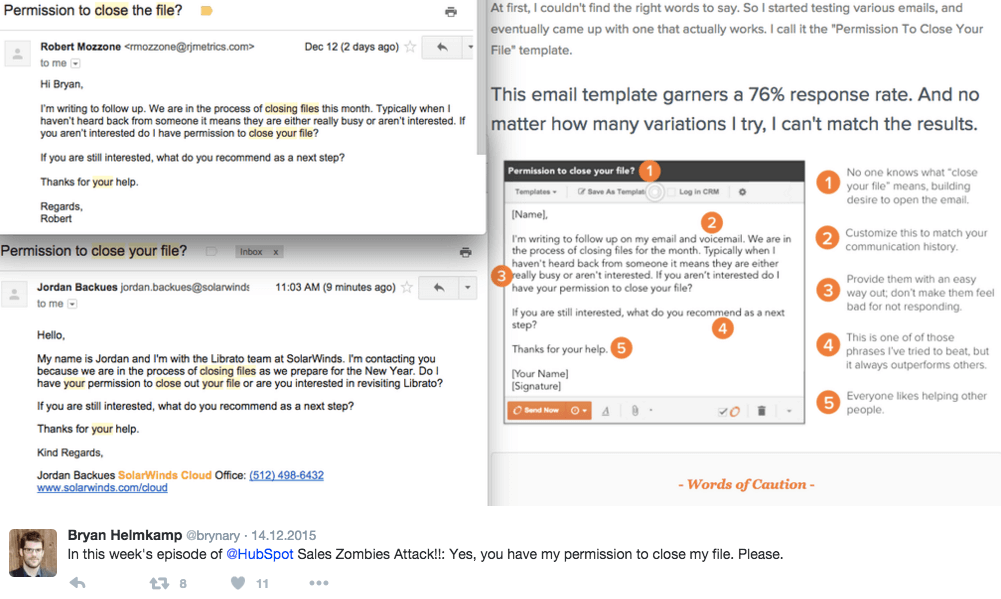
21. Slack: Difficulty with payments
Slack is incredibly popular among professionals who are generally happy with the services it offers. However, a small business owner complained that it was difficult for small businesses to get an invoice.

22. Basecamp 3: No API
Basecamp didn’t provide an API for their latest version, which didn’t resonate with some of their integration partners. According to some, a company which is known to offer advice on running a software business failed to rise up to the challenge of introducing a new version without upsetting existing users.
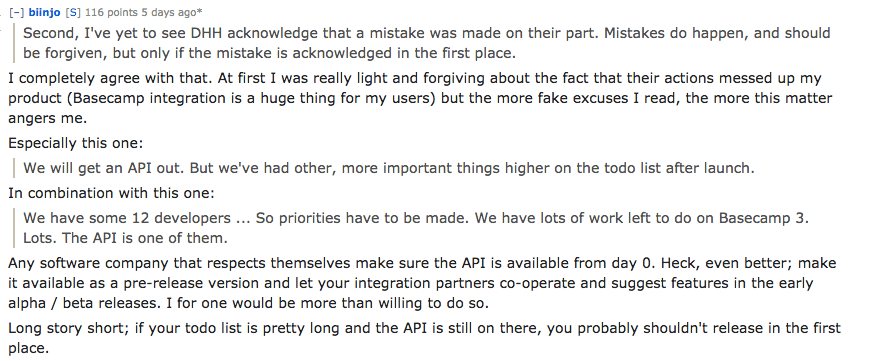
How To Improve Your SaaS?
Although the Web is full of customer complaints, it’s also teeming with inspirational stories which can give you an idea on how you can improve your product.
1. Try WebHooks
For users, WebHooks are a great way of getting valuable information about what is happening to their data in real time. Increasing numbers of SaaS businesses – e.g. MailChimp, Shopify and GitHub, offer this solution. Depending on the purpose of a particular SaaS, WebHooks can be related to e.g. received payment, new user registration, or a newsletter opt out.

2. Allow multiple users per one billing account
As mentioned above, one of the problems SaaS customers are facing is not being able to add multiple users to one billing account. It turns out many businesses saw that as an opportunity to attract new customers, e.g. via multiple or unlimited users per one billing account (typically offered in more expensive pricing plans).

3. Give a helping hand to newcomers
Learning how to navigate your tool can cause confusion for your new customers, so make sure you keep things simple to avoid losing them. Offer guides, video tutorials, webinars, screenshots with step by step how-tos, as well as a FAQ section designed to solve potential problems.

4. Make an in-person appearance
As a SaaS provider, you surely work with people all around the world – this makes it quite convenient for you to step in to solve their problems (with no suit in sight!). Offer to help by organizing regular webinars, but try to make an in-person appearance from time to time if that’s possible.

5. Think about what your customers need
It seems that the bigger the problem your SaaS is supposed to solve, the more money you can make from it. However, you have to make sure you care about your customers as much as you care about profits. Try to understand the needs of your customers and provide solutions that solve their problems. Remember that your users are not interested in all the functionalities you have to offer – they most likely care about the one that solves their problem.


6. Focus on User Experience
Your users have to find satisfaction in using your product. While a pleasant experience is bound to get more business sent your way, a few frustrating elements may make people cancel their subscription, and share their complaint with their friends…. and Google. Make sure you nip all problems in the bud by testing your product thoroughly and listening to customer feedback.


7. React to reported problems promptly
Users communicate with you in across a number of channels, such as email, helpdesk, or social media sites. Regardless of the means of communication they choose to report a problem, make sure you react as soon as possible to prevent a crisis – be polite, informative, and offer to help.

8. Ask for credit card details later in the process
Asking for credit card details upon registration may result in higher conversion rates (most customers willing to provide such information will likely be considering buying your product), but you won’t get as many trials as you possibly can. Getting people to try your tool is one of the hardest tasks you’ll probably face, and asking for credit card details early in the process is an unnecessary barrier to entry. Build trust and ask for the details later in the process to increase the number of trials and conversions.
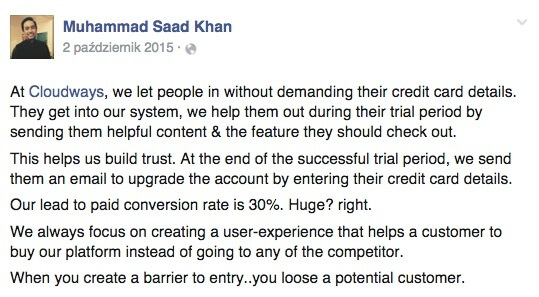
9. Allow data parking
Some of your customers may need to take a break from your tool for a while – make sure you store their data for some time to make comebacks as smooth as they can possibly be. If you’re not offering this option to your customers yet, consider whether it’s something you could do – here’s an example of how Proto.io allows customers to “park their data” for $5 a month.
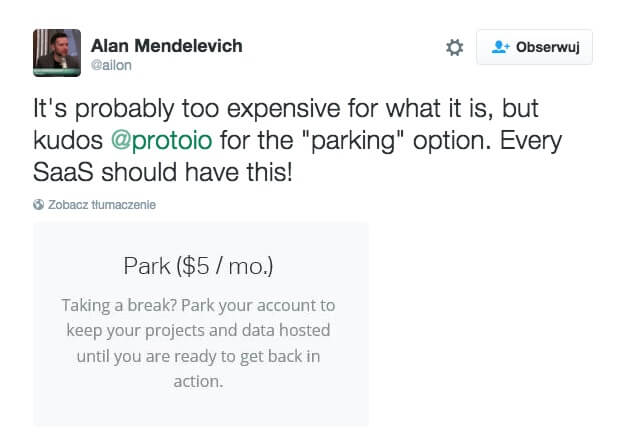
10. Take advantage of customer feedback
You may think you know your product from inside out, but when you’re so close sometimes it can be difficult to look at your product from a perspective and foresee all the applications it can possibly have.
When creating your product, think of possible scenarios to figure out potential problems your users will likely face. Luckily for you, users tend to provide feedback on what they love, as well as what they hate. Find all mentions of your product, respond to them, and consider whether the changes suggested by your users are worth implementing.

11. Create an exceptional product people will be happy to pay for
Let’s be brutally honest here: if you’re a SaaS business owner, you’ve probably spent the last few years giving your product all your heart (and all your money to boot). You probably wanted to create a solution to an existing problem and hoped people would be eager to pay to solve it with your app. You have to stand out from the crowd and offer a solution to a real problem to make people want to do that. In most cases, paying customers are better at providing you with feedback, which is also typically more constructive than that of non-paying users.

12. Use social listening to detect sales opportunities
Due to informational deluge on the Web, it can be difficult to to single out information that is relevant to a given subject. A simple yet effective way to get the answers you are looking for is to simply ask the right questions. There are plenty of places where potential customers look for the right SaaS tools. Getting notified on these questions in real time gives you a head start – with the right tool, you can be the first one to let them know you have what they are looking for.

Most Interactive Sources of Content
The Definitive Guide to Growth Hacking
The Definitive Guide to Growth Hacking by Neil Patel and Bronson Taylor was by far the most popular SaaS-related piece of content in terms of number of mentions. Although the guide comes from 2013, it is still rocking the SaaS world – in the last 8 months, it has been shared over 4,200 times across social media channels. This proves that due to being a relatively young approach, Growth Hacking intel is still in high demand.
The guide provides an explanation of the term “Growth Hacking”, presents a profile of a Growth Hacker, and discusses the Growth Hacking process. It also provides valuable advice on getting people to use your product.
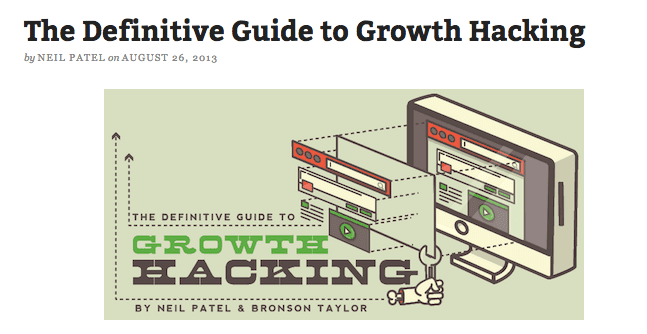
Read also: 20+ Best Growth Hacking Tools
Basecamp 3 API
Another widely discussed subject is Basecamp 3 released in November 2015. Being the first redesign of this kind since 2012, Basecamp 3 received a lot of compliments on its new functionalities and design. However, a lot of users were left unsatisfied – they couldn’t try the new version because Basecamp didn’t provide an API for their latest update. It’s been over two months now, and customers keep coming back with the same question. Basecamp team members keep on promising to provide an API soon.

Tips, Tricks & Techniques Ruled the Blog Environment
A lot of attention has been given to blog posts listing tips, tricks, techniques, and strategies, as well as SaaS-related case studies. These include:
- What removing credit cards from our SaaS signup did to our revenue,
- 16 tips to reduce SaaS churn from industry leaders.
Popular subjects related to SaaS
Growth hacking
According to data gathered by Brand24, Growth Hacking was one of the most popular subjects appearing in the SaaS context. The Definitive Guide to Growth Hacking rocked the SaaS world, but posts providing useful tips, tricks and strategies were also extremely popular. Lead generation, increasing brand loyalty, and growth hacking case studies can be found most frequently in the 61,000 collected mentions on the subject.
Inbound marketing
According to the principles of Inbound marketing, businesses should make it easy for customers to find them based on a user-centered omnichannel social media presence and high quality content.
A lot of SaaS providers choose this approach to run their business, which explains the number of mentions on that subject in the data collected in the course of this analysis. Most popular resources explained why Inbound Marketing is the right course of action, how you can get started, and where to look for useful tools. In the last 8 months, over 38,000 of mentions on the subject were collected by our tool.
PaaS and IaaS
SaaS (Software as a Service), PaaS (Platform as a Service) and IaaS (Infrastructure as a Service) are the three most common cloud computing service models. A lot of SaaS mentions were in fact related to all of these three models (e.g. were marked with three hashtags: #IaaS, #PaaS, and #SaaS at the same time). A lot of mentions mentions collected is devoted to foreseeing their development, and explaining similarities and differences between them.
Churn
Over 8,000 mentions is related to churn, which is a painful problem universally faced by SaaS providers. Across these topics, advice on minimizing churn, churn rate calculation resources, reasons why people tend to cancel their subscriptions can be found across most popular pieces of SaaS-related content.
SaaStr Annual 2016
SaaStr Annual is the biggest SaaS event of the year attended by SaaS founders, execs, and investors. The first SaaStr Annual held in 2015 was visited by nearly 2,000 SaaS professionals, but this time the event holders want this number to reach 5,000. In February alone, over 500 mentions related to the oncoming event appeared across social media channels.
Influencers
Most influential users are the people who a) are most vocal on the subject, or b) have the highest Influencer Score calculated by Brand24.
Neil Patel (@neilpatel)
Entrepreneur, investor & influencer. Columnist for Forbes, Inc, Entrepreneur, Huffington Post & more. Founded KISSmetrics, Crazy Egg, QuickSprout & Hellobar. Number of Twitter followers: 187,000.
Timothy Hughes (@Timothy_Hughes)
#2 Global #Socialselling Pioneer and Innovator, Speaker, Blogger – Prefer Algebra to Sets – Work Tweets@oracletim – Music Tweets@SM_Sounds – Views are my Mum’s.Number of Twitter followers: 137,000.
SeanEllis (@SeanEllis)
Key early growth/marketing exec at Dropbox, Eventbrite, Lookout, LogMeIn (IPO), and Uproar (IPO). Now CEO/Founder Qualaroo and Growth Hackers. Number of Twitter followers: 103,000.
Tomasz Tunguz (@ttunguz)
Venture capitalist at Redpoint Ventures. Number of Twitter followers: 37,800.
Sujan Patel (@sujanpatel)
Growth Marketer. VP of Marketing@WhenIWork. Co-Creator of ContentMarketer & @Narrowio Contributor at @Forbes, @Entrepreneur & @Inc Skydiver. Number of Twitter followers: 24,800.
Jason M. Lemkin (@jasonlk)
Pre-nicorn VC. SaaS enthusiast@SaaStr. Co-Founder CEO EchoSign (now @adobedoccloud). VP Web Biz@Adobe. Also built implantable nanobatteries. Number of Twitter followers: 20,300.
Christof Janz (@chrija)
Internet entrepreneur turned #saasinvestor. Partner at @pointninecap. Investor in @zendesk, @geckoboard,@chartmogul, @vendhq, @algolia,@typeform,…. Number of Twitter followers: 13,100.
Most prominent SaaS-related sites with the highest Influencer Score calculated by Brand24.
SaaStr (@saastr)
A curiously popular blog turned global SaaS community focused on web services people pay for. SaaStr was established in 2012 to share the learnings of Jason M. Lemkin’s on going from $0 to $100m ARR. Number of Twitter followers: 12,700.
Andreessen Horowitz (@a16z)
Andreessen Horowitz is a tech VC firm that invests in software eating the world. More about our: Portfolio Number of Twitter followers: 209,000.
SaaScribe (@saascribe)
The SaaS blog bringing you the word from the SaaS Startup Community. A publication for SaaS people by SaaS people. Number of Twitter followers: 8,300.
TechCrunch (@TechCrunch)
TechCrunch publishes tech-related news, including these from the SaaS sector. They often post rankings of businesses of all sizes, from startups to well-established companies. Apart from posting at TechCrunch, they are also active on Twitter, Facebook and Google+. Number of Twitter followers: 6.2 million.
GrowthHackers (@GrowthHackers)
GrowthHackers is an online community for professionals which aims to develop new growth marketing programmes. The discussion takes place at Growth Hackers, and across social media channels (mostly Twitter). Number of Twitter followers: 161,000.
The Cloud Network (@TheCloudNetwork)
TheCloudNetwork publishes tech news about cloud-based solutions. Number of Twitter followers: 40,600.
Cloud Blogs (@CloudBlogs)
Publications on Cloud Blogs are devoted to cloud-related solutions. Number of Twitter followers: 18,600.
Top Reads
Brand Monitoring: Tools & Guide for 2026
Brand Awareness Strategy [The Ultimate Guide for 2026]
The Best AI Hashtag Tracker and Other Hashtag Tracking Tools [2026]
Social Media Reach: How to Measure & Improve It in 2026?
X (Twitter) Analytics Tools: The 10 Best to Try in 2026
Sentiment Analysis: What is it & Why do You Need it in 2026?
Share of Voice: Definition, Calculation, Tools [2026 Guide]
Brand Reputation Management: 6 Expert Tips for 2026
A Complete Guide to AI Social Media Analysis [2025]
How to See How Many Times a Hashtag Was Used on X (Twitter)
Start Social Listening!
Get the Brand24 trial and start social listening like a PRO.